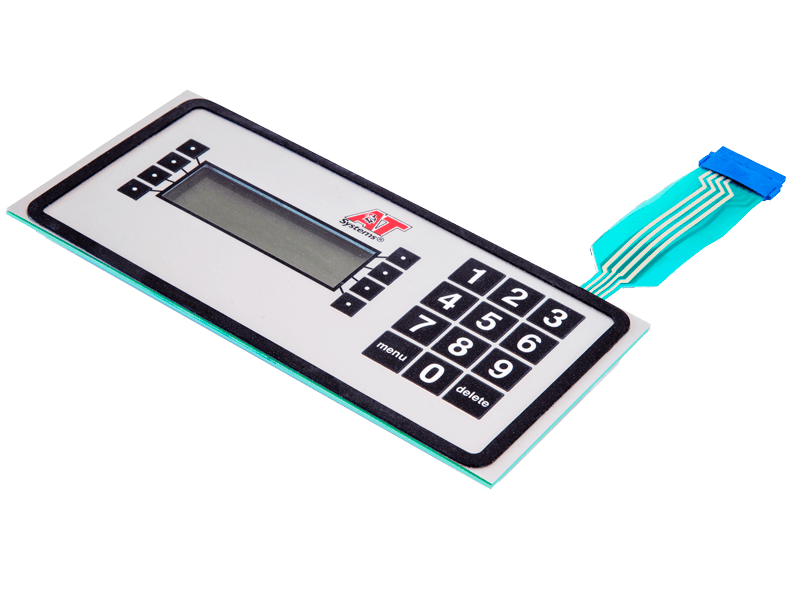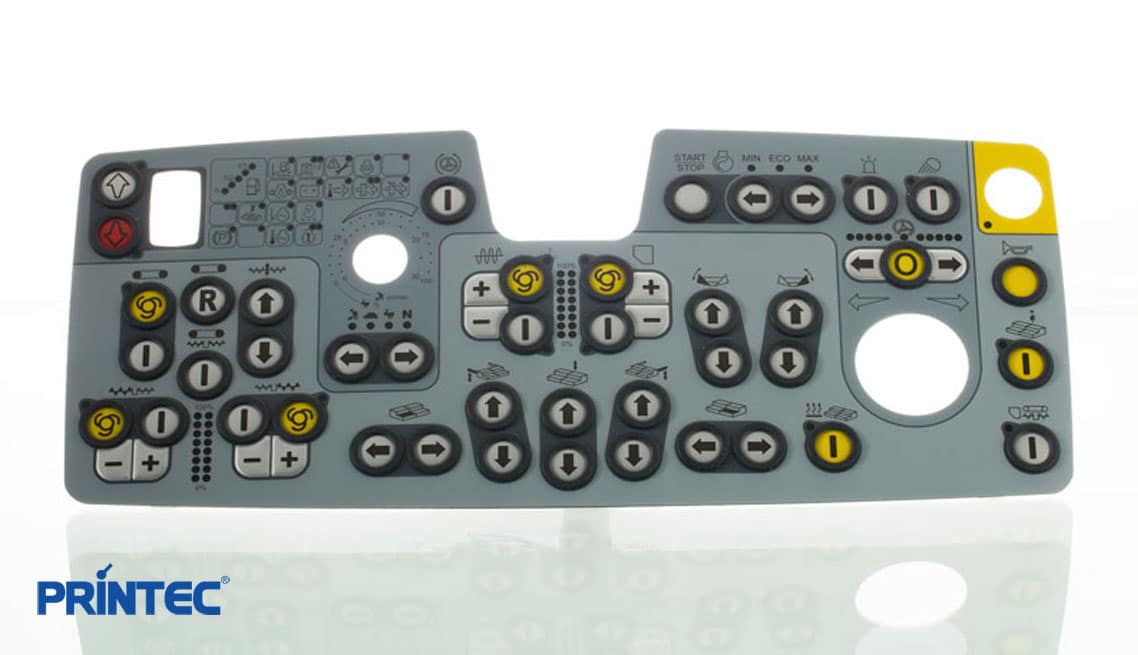What to Seek When Choosing a Membrane Switch Over for Your Project
When you're choosing a membrane button for your task, numerous crucial aspects come right into play. You'll need to assume regarding the materials, style, and just how well it straightens with your brand name.
Understanding Membrane Layer Switch Over Parts
When you dive right into the world of membrane layer buttons, it's vital to comprehend the key components that make them operate. The button typically consists of three major layers: the visuals overlay, the spacer layer, and the circuit layer. The graphic overlay provides the aesthetic user interface, displaying buttons and symbols you require for very easy navigation. Below that, the spacer layer warranties there suffices range in between the circuit and the overlay, permitting the button to activate without continuous stress.
The circuit layer, frequently made from published conductive inks, creates the electric pathways. When you push a switch, the circuit closes, sending out a signal to the device. Understanding how these layers work with each other assists you select a membrane layer switch that's dependable and fits your task requirements. Pay close focus to the thickness and product of each layer, as these elements affect durability and capability in different settings.
Product Choice and Its Impact
Choosing the right materials for your membrane layer button can greatly impact its efficiency and long life. The option of substrate, commonly polyester or polycarbonate, influences sturdiness and flexibility. Polyester is more abrasion-resistant, while polycarbonate uses much better clearness and stamina.
Following, consider the adhesive. It needs to withstand environmental factors like moisture and temperature changes. A solid glue guarantees that your membrane layer button remains intact gradually.
Don't fail to remember concerning the visuals overlay. The printing approach made use of, whether silkscreen or electronic, affects the switch's aesthetics and longevity. Top quality inks will resist fading and scratching, keeping a specialist look.
Last but not least, consider environmental conditions. If your gadget will be exposed to severe chemicals or extreme temperature levels, choose products developed to withstand these challenges. Your options in products will eventually determine the switch's dependability and customer contentment.
Layout Considerations for User Experience
Choosing the best products lays the foundation for an effective membrane switch, but the design additionally plays a considerable function in user experience. You'll wish to assess how the format impacts functionality (membrane switch manufacturer). Maintain buttons and icons intuitive and well-spaced, making it very easy for users to browse without confusion

Shade and contrast are additionally crucial; warranty that your style is aesthetically appealing however still practical. High contrast assists users quickly recognize buttons, especially in low-light problems.
Last but not least, review the total visual. A sleek and modern-day style can elevate user understanding and make your item extra enticing. Balancing performance with an appealing style will certainly lead to a far better user experience and eventually, a more effective item.

Environmental Aspects and Durability
When choosing a membrane switch, you need to take into account exactly how it'll do in different environments. Factors like temperature resistance, dampness and chemical direct exposure, and mechanical wear can significantly affect its toughness. Understanding these aspects will help you select a switch that withstands your certain problems.
Temperature Resistance Demands
As ecological problems can vary commonly, understanding temperature resistance is essential for ensuring the durability of your membrane layer switch. Make certain to examine the requirements of the products utilized in the button, like the adhesive and overlay, as they directly influence efficiency. By selecting a membrane layer button with sufficient temperature level resistance, you'll enhance its life-span and preserve functionality in difficult settings.

Dampness and Chemical Exposure
Dampness and chemical direct exposure can significantly influence the performance and long life of your membrane layer switch, so it's crucial to comprehend the setting in which it will certainly be made use of. If your job entails high humidity or exposure to liquids, look for safety coatings and sealants that can improve resistance to dampness. In addition, consider the sorts of chemicals your button may run into. Certain materials can deteriorate when exposed to solvents, oils, or severe cleansers. Picking the best products, like polycarbonate or polyester, can help withstand these aspects. Always consult the producer's specs for chemical compatibility to ensure your membrane layer button keeps its capability with time. By prioritizing wetness and chemical resistance, you can improve the toughness of your button in challenging atmospheres.
Mechanical Deterioration
While you may prioritize attributes like aesthetics and capability in your membrane layer button, mechanical wear and tear can significantly affect its efficiency gradually. Think about exactly how typically the button will certainly be utilized and the setting it'll be in. Regular pushing can result in deterioration of materials, triggering issues like tactile feedback loss or even change failure. Try to find models with durable designs, such as those with safety overlays that resist scratches and put on. Furthermore, check for specs on cycle life, which indicates exactly how many presses the button can take care of before revealing signs of wear. Selecting a resilient switch warranties longevity and dependability, protecting against pricey substitutes and downtime in your task. Always consider durability along with looks and capability for peak performance.
Modification Options for Branding
When it comes to branding your membrane button, modification alternatives are key. You can choose design aspects and colors that show your brand name, together with specific logo design placement and dimension to improve exposure. Furthermore, choosing the appropriate materials and structures can elevate the total informative post look, making your item stand apart.
Design Elements and Shades
A large range of layout aspects and shades can make your membrane switch not just functional but likewise visually attractive, improving your brand name identification. When selecting shades, consider your brand's scheme; they must reverberate with your target market and stimulate the right feelings. You can also explore numerous coatings like matte or glossy to develop various visual effects. Don't forget textures; adding a tactile component can enhance customer experience and make your button attract attention. Take into consideration including personalized graphics or patterns that line up with your brand name message. By attentively selecting layout aspects and shades, you not just produce a product that looks terrific yet also reinforces your branding regularly and efficiently.
Logo Placement and Size
After finalizing your design components and shades, the following action is to focus on logo positioning and size. Your logo is a crucial element of your branding, so you'll desire it to stand out without frustrating various other layout components. Mirror on where your logo design will be most noticeable and impactful; common positionings consist of the top or center of the button.
Think of the dimension also-- too big and it may eclipse practical components, also small and it might get lost. Go for a balance that allows your logo to be quickly well-known while maintaining the total visual appeals. Don't neglect to consider how the logo design straightens with customer communication. This attention to detail will certainly improve both capability and brand name identity in your task.
Material and Texture Alternatives
Choosing the ideal materials and appearances for your membrane button can greatly improve both its functionality and aesthetic appeal. You'll wish to evaluate alternatives like polyester or polycarbonate, as they provide sturdiness and resistance to wear. The appearance of the surface likewise plays a necessary duty; smooth surfaces give a smooth explanation look, while distinctive surface areas can enhance grasp and responsive comments.
Customizing the materials and textures allows you to mirror your brand name identification properly. For example, you might select a matte surface to communicate refinement or a shiny seek a modern-day touch - membrane switch manufacturer. Don't forget color alternatives, as lively colors can make your switch stand apart, while low-key tones can create a more sophisticated look
Cost vs. High Quality: Finding the Right Balance
When you're taking care of the alternatives for membrane buttons, stabilizing cost and quality can really feel overwhelming. You intend to guarantee that you're getting a reliable item without damaging the bank. Start by recognizing your project's specific requirements. Are you focusing on longevity or aesthetic appeals? A lower-cost switch might conserve you cash upfront, but if it endangers capability, you might face greater replacement prices later on.
Try to find manufacturers that use a good mix of affordability and high requirements. Study their track record and consumer testimonials to gauge reliability. Sometimes, investing a bit more in top quality products can conserve you from future headaches.
Also, consider the long-term efficiency and warranty options. A somewhat extra pricey switch with a strong warranty might prove to be a smarter investment. Inevitably, it has to do with discovering that pleasant place where you fulfill your budget plan while ensuring your project's success.
Evaluating and Quality Control Protocols
While you could find the best membrane layer button design, assuring its quality with strenuous testing protocols is important for lasting success. Begin by confirming that the supplier adheres to sector requirements, such as IPC/WHMA-A -620, to ensure a reputable item. membrane switch manufacturer. You'll want to look for complete screening techniques, consisting of environmental, mechanical, and electric assessments
Make sure the buttons go through durability testing, replicating real-world use to identify any type of potential failings. Take notice of the maker's quality guarantee process, which must include regular inspections and audits.

Don't fail to remember to request examples and conduct your own examinations to confirm compatibility with your job. Ultimately, consider exactly how frequently the manufacturer updates their methods; technology in testing can lead to better high quality. By prioritizing these screening and top quality guarantee methods, you'll boost the likelihood of an effective and sturdy membrane switch for your application.
Frequently Asked Inquiries
Exactly how Lengthy Does a Membrane Layer Change Typically Last?
A membrane layer switch generally lasts anywhere from 1 to 10 million cycles, depending upon use and environmental elements. You'll wish to consider your certain requirements to ensure it fulfills your longevity demands properly.
Can Membrane Layer Changes Be Repaired if Harmed?
Yes, you can often repair membrane switches if they're damaged, but it frequently depends on the level of the damage. Minor concerns may be reparable, while a lot more substantial damages normally calls for replacement for appropriate performance.
What Are the Typical Applications for Membrane Layer Switches?
Membrane layer buttons are generally made use of in appliances, medical gadgets, and automotive controls. You'll locate them in consumer electronic devices, industrial equipment, and even pc gaming consoles. Their flexibility makes them optimal for different interface and settings.
Are There Details Certifications for Membrane Switches?
Yes, there are details accreditations for membrane buttons. Seek UL, CE, and RoHS qualifications to ensure safety and security and conformity. These accreditations suggest the switch fulfills industry criteria for high quality and ecological security.
Just how Do I Make Certain Correct Installation of a Membrane Switch?
To assure proper installment of a membrane button, clean the surface area extensively, align it meticulously, and apply even stress. Adhere to maker guidelines for adhesive curing time to make the most of sturdiness and functionality.
Final thought
When picking a membrane switch for your project, keep these crucial elements in mind: focus on durable products, focus on straightforward layout, and take into consideration personalization for your brand. By thoroughly assessing these aspects, you'll guarantee your membrane switch not just fulfills your job needs yet additionally improves customer experience and shows your brand name find this identification efficiently.